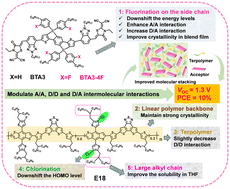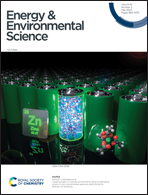Modulating intermolecular interactions by collaborative material design to realize THF-processed organic photovoltaic with 1.3 V open-circuit voltage†
Abstract
Achieving efficient exciton dissociation and high power conversion efficiency (PCE) becomes a great challenge when the open-circuit voltage (VOC) of organic photovoltaics (OPVs) reaches an upper limit value of 1.3 V or higher. The balanced intermolecular interactions of donor/donor (D/D), acceptor/acceptor (A/A) and donor/acceptor (D/A) determine the molecular stacking, crystallinity, morphology and subsequent exciton dissociation, but there is a lack of relevant material design guidelines to simultaneously modulate the three interactions. Herein, we rationally design a terpolymer E18 by introducing a 20% proportion of the side chain with a chlorine atom and bulky alkyl chain to the classic p-type polymer D18, and we also obtain a non-fullerene acceptor BTA3-4F by adding four fluorine atoms on the side chain of the middle D unit of A2–A1–D–A1–A2 type molecule BTA3. As expected, the collaborative material design guarantees that E18:BTA3-4F achieves the balanced A/A, D/D and D/A intermolecular interactions in the blend film, resulting in tighter large-area molecular stacking and excellent vertical phase separation. Thus, the nonhalogenated solvent tetrahydrofuran (THF) processed OPV device based on E18:BTA3-4F realizes the highest PCE of 10.03% with a VOC of 1.30 V and a non-radiative energy loss (ΔE3) of 0.18 eV. In contrast, the E18:BTA3 combination exhibits a VOC of 1.32 V and a ΔE3 of 0.12 eV with an inferior PCE of 4.98%. Our results provide wide bandgap material design guidelines to optimize intermolecular interactions, and thus realize efficient exciton dissociation for the OPV devices with a VOC of 1.3 V or higher.



 Please wait while we load your content...
Please wait while we load your content...